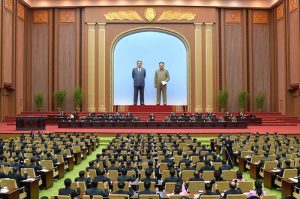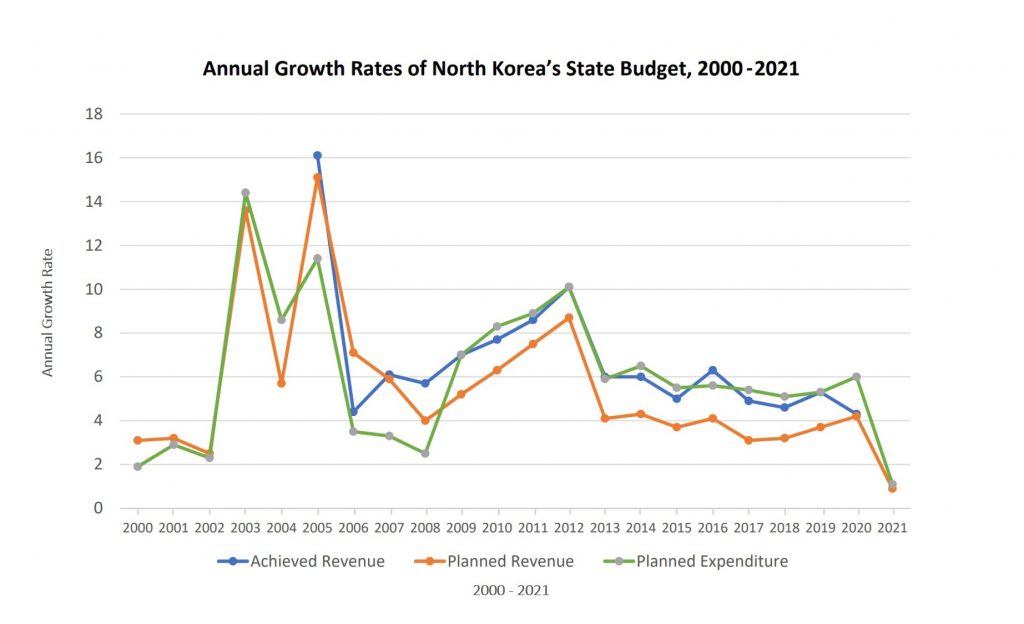SPA Session: Lowest Official Growth Rate in Decades

The annual session of the North Korean parliament, the Supreme People’s Assembly (SPA), was held on January 17, 2021. The SPA’s role is to implement the strategic decisions made by the Korean Workers’ Party (KWP); the session was thus directly connected to the decisions made at the Eighth Party Congress, which had taken place just days before. As usual, the key documents were the report on the economy by a representative of the Cabinet, and the report on the state budget.
The most striking detail from these reports is the historically low projected growth rate of state budget revenue of only 0.9 percent. This is the lowest official rate since the economic crisis of the mid-1990s. It corrects the unrealistically high growth expectation for 2020, shows the readiness of the North Korean leadership to be relatively honest about economic difficulties, and offers a glimpse into the cautious outlook of the North Korean state on its economic development in 2021.
Speech by the Prime Minister: Echoing Kim Jong Un’s Report at the Party Congress
Highlighting the leading role of the KWP over the parliament, a number of high-ranking party members were present, including three out of five members of the Presidium of the Politburo. Among them, two hold key posts in the parliament and in government: Choe Ryong Hae, who is president of the SPA Presidium and the first vice-chairman of the State Affairs Commission, and Kim Tok Hun, the prime minister.
The report by the prime minister followed the usual choreography of such events. He first looked back at past achievements, which were all credited to Kim Jong Un’s wise leadership. He then echoed the leader’s critical remarks at the Party Congress in the same relatively careful and general way by pointing at “serious mistakes” (심중한 결함들). It should be noted that, unlike the official English translation, the Korean version of the report included a few more details, including the failure to meet the targets of energy production and criticism of Cabinet members for formalism and sticking to “outdated methods” (구태의연한 사업방식).[1]
The future plans of the Cabinet reflect Kim Jong Un’s report at the Party Congress: Self-reliance, self-sufficiency and import substitution as key economic policies; a strategic priority on metal and chemical industries; and growth in all other areas. The prime minister also stressed the need to restore the state’s control in the economy (국가의 주도적역할, 조절통제력을 회복하고). As noted above, the Korean version of the report contains more specifics compared to the English version. In addition, Kim Tok Hun mentioned new technologies for steel production, the updating of mining equipment in Musan and Unryul, and an increase in the production of chemical fertilizer, caustic soda and synthetic resin. In power production, transmission losses are to be reduced, and “voltage levels are to be increased” (전압단계를 올리다). The prime minister also reiterated Kim Jong Un’s announcement to build nuclear power plants (핵동력공업창설). To increase cement production, the Sunchon Cement Complex will be modernized.[2]
In foreign trade, “scientific strategies” (과학적인 전략) are to be implemented, suggesting a return to central planning and steering rather than a continued decentralization of decision making by individual enterprises. This interpretation is supported by remarks of the prime minister, who vowed to “establish discipline to realize the state’s unified guidance on economic projects” (경제사업에 대한 국가의 통일적지도를 실현하기 위한 기강을 바로 세우다).[3]
Like Kim Jong Un in his report at the Party Congress, Kim Tok Hun did not mention agriculture until relatively late in his report. How should we interpret this absence of urgency? From an optimistic perspective, it could be an indicator that the North Korean government is confident it has reached a level of domestic production to sufficiently feed its population, or that it expects to be able to import enough food in 2021. Such a positive outlook is supported by the fact that the prime minister repeated his leader’s strong calls for reducing the gap between rural and urban areas, indicating the state is indeed willing to put a focus on rural development—which could include further investment into an improvement of food production.
In the worst case, however, it means the North Korean state is under such economic pressure that it is willing to at least temporarily channel its scarce resources into strategic areas so as to promote import substitution of key industrial inputs—at the expense of food production. Combined with existing hardships due to sanctions and COVID restrictions, and the high risk of disruptions due to natural disasters, the humanitarian consequences of this kind of decision could be dramatic.
The Budget Report: The Numbers Are Low but Consistent
The report on the state budget was delivered by the new Minister of Finance, Ko Jong Bom. The timing was unusual and must have placed officials in the related ministries under great stress, as it is normally delivered in March or April. But this deviation from standard practice was due to the timing of the Party Congress and should thus not be interpreted as a sign of economic urgency.
Despite all reservations about North Korean official numbers, a comparison of the state budget’s actual and projected growth rates over time does offer insights into the DPRK’s macroeconomic development. Considering the state’s ownership of the economy, the growth rates of the state budget can be used as proxies for gross domestic product (GDP) growth.
The figures should be treated as being only indicative, and there are manifold methodological issues. For example, it is unclear whether the growth rates consider inflation; moreover, the data do not include the substantial part of the North Korean economy that is operated directly by the military (the so-called “second economy”) or the share of GDP generated by private or semi-private economic activities. Furthermore, only percentages are provided, not absolute numbers. Given these limitations, a comparative analysis seems to be the most prudent approach.
Figure 1 attempts this and shows the official budget growth rates over the past two decades.
Figure 1. Annual Growth Rates of North Korea’s State Budget, from 2000-2021.

The most striking feature of this graph is the sharp decline in projected growth to a historic low of only 0.9 percent. The 2021 budget report provided many more insights into the status of North Korea’s economy.[4] Most of them are alarming.
At the SPA meeting in April 2020, North Korea’s budget report projected 2020 revenue to grow 4.2 percent, although it presented much lower growth expectations for the main components of that revenue (transaction taxes and profits from state enterprises)—only around 1 percent. Such an obvious contradiction was unusual and most likely reflected some internal confusion due to the onset of the COVID crisis.
In this year’s budget report, the authorities corrected what must have been a technical error by claiming a remarkably high growth rate of 4.3 percent in achieved revenue for 2020.[5] Considering the major economic difficulties that North Korea (as the rest of the world) experienced in 2020 due to the global pandemic, it is very likely this claim is false. It seems the Cabinet officials in charge of these figures had to choose between two evils: publishing a negative growth rate for 2020, or sticking with their original wrong projection and then silently adjusting the growth target for 2021 down to more sober levels. They went for the latter option.
Accordingly, the new finance minister projected a historically low growth rate for 2021 of only 0.9 percent in planned revenue. The latter now again, unlike last year, corresponds quite well with the projected growth rates for transaction tax (0.8 percent) and profits of state enterprises (1.1 percent).[6]
But while the figures are now consistent again, their values still raise questions. Most countries assume an economic rebound will take place after the end of the COVID crisis. Therefore, it is somewhat surprising to see such a modest growth expectation for 2021, especially in light of the newly adopted five-year plan. We can only speculate about the reasons. Is this a reaction to Kim Jong Un’s criticism of bad and unrealistic planning? Do North Korean economists expect the current difficulties to last for one more year—or have they decided to set a low target that can be more easily overfulfilled?
Other details from the budget report strongly support the notion that the official economic outlook for 2021 is indeed grimmer than the still optimistic wording would imply. Several days ago, the North Korean leader stressed the high priority of key industries of his economy—including metal and chemical industries—without, however, providing any numbers. Now in the budget report, we find a projected growth rate for these priority sectors of only 0.9 percent. Just one year before, this rate was eight times higher (7.2 percent). The increase in funds to be spent in 2021 for science and technology is equally meager, with just 1.6 percent growth versus 9.5 percent in 2020. Expenses in the field of sports are supposed to grow by 1.6 percent compared to 4.3 percent in 2020; expenditures for public health are expected to grow by 2.5 percent this year, compared to last year’s figure of 7.4 percent.[7] The latter is particularly remarkable considering the current health crisis and the fact that the Pyongyang General Hospital has not yet been completed despite plans to open it in October 2020. In fact, the hospital was not mentioned in Kim Jong Un’s report to the Party Congress or in any report at the SPA session.
Gloomy Days Ahead
At the very least, the 2021 budget report is not very optimistic. In fact, the projected growth numbers are at the lowest level in decades. Considering that for propaganda reasons, official numbers usually tend to paint an overly positive image, we must conclude that North Korea finds itself in deep economic difficulties. Along with the lessons drawn from Kim Jong Un’s speech at the Eighth Party Congress, this economic hardship provides reasons to expect even closer economic cooperation with China in 2021, greater vigilance against domestic ideological deviations, and increased potential for a worsening humanitarian situation. It remains unclear, however, whether this economic stress will also make North Korea more open to talks with South Korea, the United States and Japan. In fact, the opposite could happen: Domestic economic uncertainty might dissuade Kim from engaging in politically risky endeavors in external relations.
- [1]
Author translation of “최고인민회의 제14기 제4차회의에 제기한 내각사업보고,“ KCNA, January 18, 2021.
- [2]
- [3]
Ibid.
- [4]
- [5]
Ibid.
- [6]
Ibid.
- [7]
See: Ibid.; and “Implementation of State Budget for Juche 108 (2019) and State Budget for Juche 109 (2020),” KCNA, April 13, 2020.
